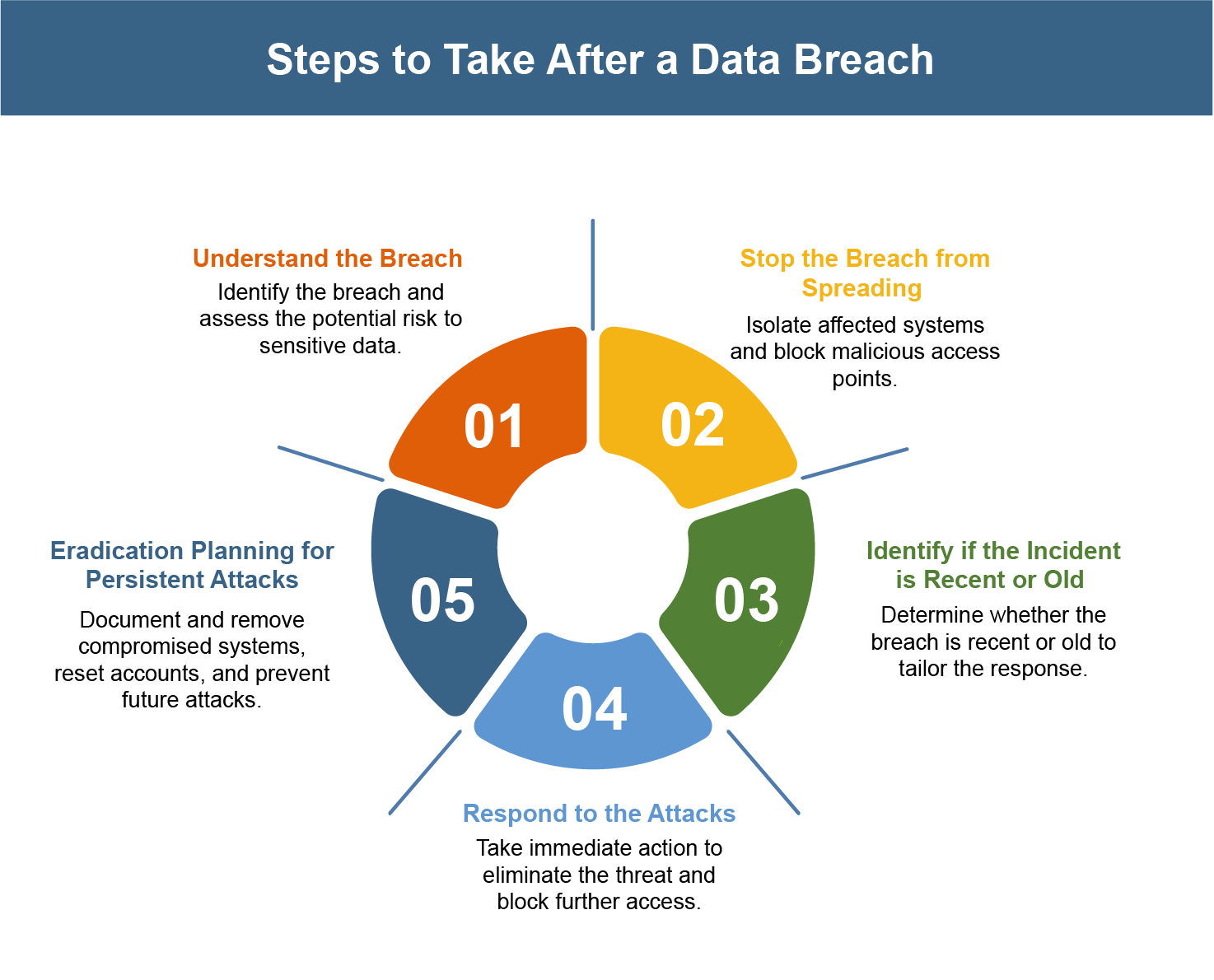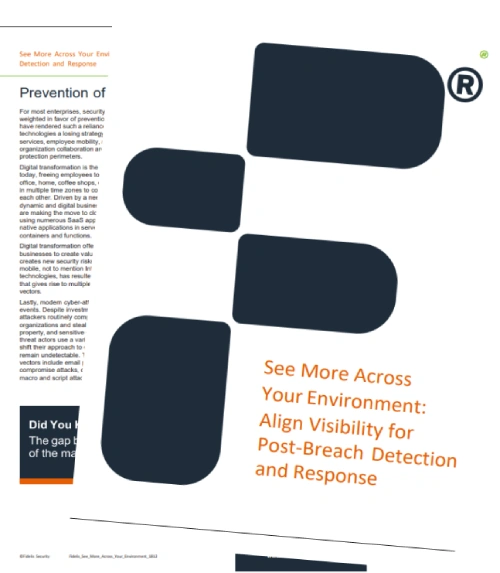Breaking Down the Real Meaning of an XDR Solution
Read More As data travels across networks, it becomes vulnerable to interception. To safeguard
Want to stay ahead of threats in 2025? This research report is all you need to stay updated.
Cyberattacks and data breaches can’t be completely stopped in a day. As technology grows, attackers find different ways to intrude, constantly adapting to new security measures. Gartner forecasts that by 2027, generative AI will play a role in 17% of all cyberattacks, highlighting the growing threat of AI-driven tactics in the evolving landscape of cybersecurity. So, companies should always get ready to cope with any kind of sophisticated attacks at any time.
But what if you cannot defend because the attackers have already intruded into your system and a data breach occurs?
Let’s discuss the 5-step best practices for a business after a data breach occurs in detail.

The first 72 hours matter a lot in data breach response and incident detection. Security breaches are not very apparent in the systems in the beginning. It can be an unusual activity or alerts from systems like SIEM, network monitoring tools, or external sources (e.g., law enforcement agencies or trading partners).
So, begin by answering these questions:
The mistake that the security team often makes is taking immediate action to fix the issue (e.g., taking systems offline), which is a typical reaction even before understanding the attack. This can make the situation worse and cause more damage than the attacker caused.
First, understand the breach and contain it, ensuring no further escalation or damage, because:
The quicker you act, the less damage the breach will cause. Identifying the incident type helps you respond properly and reduce its impact.

Next, you need to focus on preventing the escalation. For that, ensure that you revoke any compromised account access information immediately to prevent the attacker from gaining further access to sensitive systems or customer data.
For that,
Stopping the attacker from spreading ensures you can manage the cyber incident effectively.
How you respond to a security incident depends on two things:
There are two main types of incident detection that security teams typically deal with:
| Factor | Incursion Detection | Persistence Detection |
|---|---|---|
| Description | Identifying recent attacks within the first 48 hours. | Attacker has been inside the network for months or years, with a persistent foothold. |
| Investigation Duration | 1–3 weeks | 2–4 months |
| Challenges | Easier to resolve and trace the root cause. | Harder to trace the root cause; investigation takes longer due to extended attacker presence. |
In persistence detection, the investigation usually takes longer because it’s harder to trace when and how the attack started. It is often drawn out because the information needed is slow to collect, and it’s hard to pinpoint the original infiltration point.
If your security system is capable of tracking attacker behavior, it can help in understanding the attacker’s tactics and movement faster and more efficiently.
Once you determine if the breach is recent or continuing, you can apply a more focused data breach response process to reduce further damage and prevent future attacks.
The main focus of incident response should be to stop the attacker from gaining a permanent foothold. Attackers often use custom malware, command-and-control setups, and exploits to get in.
Common attack techniques to watch for:
Assign the roles and responsibilities to team members for a systematic incident response without any confusion.
The response team will continue carrying out their roles as outlined for the first 72 hours.
Check the below table for a better understanding:
| Timeframe | Role | Actions |
|---|---|---|
| 0-24 Hours | Network Admins | Pull network diagrams and identify involved IPs. |
| System Admins | Quarantine affected systems. | |
| Tech Admins | Collect copies of malware. | |
| Security Team | Identify tools that detect the attack, remove malware, set fraud alerts, and block malicious communication. | |
| Incident Response Lead | Initiate incident tracking and escalate the situation. | |
| Security Management | Report to executives and inform departments. | |
| 24-48 Hours | Network Admins | Continue classifying the network. |
| System Admins | Continue quarantining systems. | |
| Tech Admins | Analyze suspicious behavior. | |
| Security Team | Perform lookups for compromised IPs, accounts, and malware. Update security tools. | |
| Incident Response Lead | Begin documenting details, keep leadership informed. | |
| Security Management | Investigate the reason for the attack and support the IR team. | |
| 48-72 Hours | Network Admins | Maintain standby status. |
| System Admins | Continue quarantining systems. | |
| Tech Admins | Continue analyzing behaviors. | |
| Security Team | Finalize incident details and implement remediation measures. | |
| Incident Response Lead | Provide status updates, and formalize lessons learned | |
| Security Management | Prepare for post-incident training. |
For persistence detection incidents, internal teams may not have the required expertise to handle long term threats, particularly if the attacker has maintained access for months or years. In these cases, seeking external Incident Response teams is highly recommended.
The response activities include resetting user accounts, removing malware, remediating systems, blocking malicious IPs, and using custom signatures for active defense tools. In larger organizations, this could involve many user accounts, systems, and types of malwares.
These experts have the tools and knowledge to track and remove the threat, especially when it’s hard to find how the attacker got in. They also conduct thorough investigations to make sure no backdoors remain.
Even after isolating the breach and determining its scope, several challenges and delays could affect the overall effectiveness of your response.
Key challenges that can cause delays in incident response:
In this step, you need to focus on:
Work on coordinated eradication:
Coordinate across systems and user accounts to ensure thorough and efficient remediation. And keep the leadership and stakeholders updated at each step.
Use lessons learned to update your security protocols and strategies, such as fixing identified vulnerabilities, improving access controls, and providing detailed employee training on phishing and other social engineering tactics.
Learn how the event happened and identify the security vulnerabilities and gaps that allowed the attack to succeed. Was it phishing? Misconfigured settings? Or some other reason?
Identify where your security failed—missed updates, weak passwords, or other gaps.
Write down the details so you can prevent it from happening again.
You should also focus on identifying the business requirements after data breach, such as increasing staff resources or investing in new tools for more efficient detection and prevention of future attacks.
Update your security plans based on what you learned. Adjust response times and improve detection tools (like AI or threat intelligence).
Execute your new security strategies with the team to ensure they’re powerful and help the team respond to similar issues in the future.

Ensure that your business continuity plan after a data breach is well-established. This will help restore critical systems quickly and continue operations without any disruption.
Make sure critical systems can be quickly restored after a breach, and employees know their roles during recovery.
Regularly back up your systems to avoid data loss in case of another attack.
Make sure third-party vendors follow your security protocols to avoid weak links in your security chain.
A large part of rebuilding your consumer confidence after data breach involves communicating transparently with customers, partners, and internal teams about what happened and how you’re preventing future incidents.
Keep customers, partners, and your internal teams informed about what happened, how you’re going to fix it, and how you will prevent it in the future.
Repair any damage to the company reputation after a data breach. Consider offering identity theft protection services or support for those affected by the breach.
Watch how people are reacting and adjust your actions to rebuild trust.
If any third-party vendor was affected by the breach, review their security measures to ensure they align with your standards.
Be cautious about granting vendors access to the systems and ensure they strictly follow the security protocols.
As you implement a robust security strategy post-breach, adopting an advanced security solution like Fidelis Elevate®, an XDR, can provide the comprehensive protection your organization needs to stay resilient against future threats.
Prevention is always better than cure. So, protect your data and IT infrastructure way ahead of threat actors with Fidelis.
A holistic approach with Extended Detection and Response (XDR) is essential to proactively protect your data and ensure business continuity.
Fidelis Elevate® is an industry-leading XDR platform that integrates Endpoint Security, Network Security, Deception, DLP, and Active Directory Protection in a single solution. With advanced capabilities, it helps you detect, assess, and mitigate threats faster and more effectively.
Download our Datasheet to learn more about Fidelis Elevate® and see how it can transform your cyber and data security landscape with its rich and advanced features.

After a breach, reviewing the incident and making continuous improvements helps your organization learn and grow stronger. By understanding the cause, updating your security plans, and rebuilding customer trust, you’ll be better prepared for future attacks. Ongoing monitoring and securing vendor relationships will keep you ahead of threats.
Now is the time to assess your incident response plan and ensure your team is ready. Strengthen your defenses and invest in ongoing improvement to stay protected!
The first step is to understand the breach. Then check if it’s a real security issue and figure out what sensitive data may be at risk, and plan how to respond. Make sure to isolate affected systems and notify stakeholders within the first 72 hours to contain the damage.
To stop a breach from spreading, you should:
This helps ensure that the attack is contained and doesn’t escalate.
A recent breach, called incursion detection, is easier to handle because the attacker hasn’t been in your system for long. It usually takes 1-3 weeks to investigate. However, if the attacker has been inside your network for months or even years (persistence detection), it can take longer to figure out when and how they entered, and the investigation may take 2-4 months.
After isolating the breach, focus on preventing the attacker from maintaining a foothold. Common tactics to watch for include:
The goal is to eliminate these threats, block further attacks, and prevent the attacker from re-entering.
To fully eradicate the attack, you need to:
Pallavi is a tech writer with a deep enthusiasm for cybersecurity and emerging technologies. With a keen interest in digital security, she simplifies complex concepts and provides valuable insights to help businesses stay ahead and effectively navigate the ever-evolving cybersecurity landscape.
See Fidelis in action. Learn how our fast and scalable platforms provide full visibility, deep insights, and rapid response to help security teams across the World protect, detect, respond, and neutralize advanced cyber adversaries.